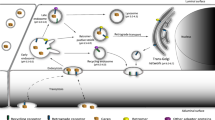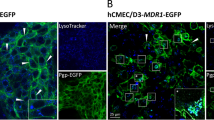Abstract
We examined whether pretreatment of mouse brain blood vessel endothelial cell clone 4 (MBEC4) cells with sodium nitroprusside (SNP), a NOx donor, as an in vitro model of the bloodbrain barrier could affect P-glycoprotein (P-gp) functional activity. Uptake into the cells and MBEC4 plasma membrane vesicles (MPMVs) in the presence or absence of SNP pretreatment was used to investigate functional changes. Increased accumulation of [3H]vincristine, a widely used substrate for P-gp, into MBEC4 was observed upon SNP pretreatment, likely due to impaired P-gp function. To better understand the mechanism of the impairment, MPMVs were prepared and characterized in terms of purity and Na+-dependent glucose uptake. [3H]daunomycin uptake into MPMVs was diminished after SNP pretreatment in the presence of an ATP-regenerating system, indicating that the functional activity of P-gp was impaired after exposure to SNP. Under conditions of excess ATP, daunomycin uptake into the vesicles was still decreased after SNP pretreatment, indicating that SNP interacted directly with the transport system, but not with the ATP-regenerating system. Together, these results suggest that NO or NOx functionally impairs P-gp in the in vitro blood-brain barrier model with SNP pretreatment.
Similar content being viewed by others
References
Ahn, S.-H., Jeon, S.-H., Tsuruo, T., Shim, C.-K., and Chung, S.-J., Pharmacokinetic characterization of dehydroevodiamine in the brain. J. Pharm. Sci., 93, 283–292 (2004).
Böhme, M., Müller, M., Leier, I., Jedlitschky, G., and Kepper, D., Cholestasis caused by inhibition of the adenosine triphosphate-dependent bile salt transport in rat liver. Gastroenterlogy, 107, 255–265 (1994).
Buffoli, B., Pechanova, O., Kojsova, S., Andriantsitohaina, R., Giugno, L., Bianchi, R., and Rezzani, R., Provinol prevents CsA-induced nephrotoxicity by reducing reactive oxygen species, iNOS, and NF-κB expression. J. Histochem. Cytochem. 53, 1459–1468 (2005).
Celedon, G., Gonzales, G., Pino, J., and Lissi, E. A., Peroxynitrite oxidizes erythrocyte membrane band 3 protein and diminishes its anion transport capacity. Free Radic. Res., 41, 316–323 (2007).
Choi, M.-K., Kim, H., Han, Y.-H., Song, I.-S., and Shim, C.-K., Involvement of Mrp2/MRP2 in the species different excretion route of benzylpenicillin between rat and human. Xenobiotica, 39, 171–181 (2009).
Cumaoglu, A., Stefek, M., Bauer, V., Ari, N., Aricioglu, A., and Karasu, C., Glycoxidative and nitrosative stress in kidney of experimental diabetic rats: effects of the prydoindole antioxidant stobadine. Neuro. Endocrimol. Lett., 31, 313–318 (2010).
Delwing, D., Cornelio, A. R., Wajner, M., Wannmacher, C. M., and Wyse, A. T., Arginine administration reduces creatine kinase activity in rat cerebellum. Metab. Brain Dis., 22, 13–23 (2007).
Han, H., Kim, S. G., Lee, M. G., Shim, C.-K., and Chung, S.-J., Mechanism of the reduced elimination clearance of benzylpenicillin from cerebrospinal fluid in rats with intrasisternal administration of lipopolysaccharide. Drug Metab. Dispos., 30, 1214–1220 (2002).
Homma, M., Suzuki, H., Kusuhara, H., Naito, M., Tsuruo, T., and Sugiyama, Y., High-affinity efflux transport system for glutathione conjugations on the luminal membrane of a mouse brain capillary endothelial cell line (MBEC4). J. Pharmacol. Exp. Ther., 288, 198–203 (1999).
Hughes, M. N., Chemistry of nitric oxide and related species. Methods Enzymol., 436, 3–19 (2008).
Kaasik, A., Minajeva, A., Sousa, E. D., Ventura-Clapier, R., and Veksler, V., Nitric oxide inhibits cardiac energy production via inhibition of mitochondrial creatine kinase. FEBS Lett., 444, 75–77 (1999).
Kalitsky-Sziretes, J., Shayeganpour, A., Brocks, D. R., and Piqutte-Miller, M., Suppression of drug-metabolizing enzymes and efflux transporters in the intestine of endotoxintreated rats. Drug Metab. Dispos., 32, 20–27 (2004).
Kusuhara, H., Suzuki, H., Naito, M., Tsuruo, T., and Sugiyama, Y., Characterization of efflux transport of organic anions in a mouse brain capillary endothelial cell line. J. Pharmacol. Exp. Ther., 285, 1260–1265 (1998).
Lowry, O. H., Rosebrough, N. J., Farr, A. L., and Randall, R. J., Protein measurement with the folin phenol reagent. J. Biol. Chem., 193, 265–275 (1951).
Maeng, H.-J., Kim, M.-H., Jin, H.-E., Shin, S. M., Tsuro, T., Kim, S. G., Kim, D.-D., Shim, C.-K., and Chung, S.-J., Functional induction of P-glycoprotein in the blood-brain barrier of steptozotocin-induced diabetic rats: evidence for the involvement of nuclear factor-kappaB, a nitrosative stress-sensitive transcription factor, in the regulation. Drug Metab. Dispos., 35, 1996–2005 (2007).
Obrosova, I. G., Mabley, J. G., Zsengeller, Z., Charniauskaya, T., Abatan, O. I., Groves, J. T., and Szabo, C., Role for nitrosative stress in diabetic neuropathy: evidence from studies with a peroxynitrite decomposition catalyst. FASEB J., 19, 401–403 (2005).
Park, S. U., Ferrer, J. V., Javitch, J. A., and Kuhn, D. M., Peroxynitrite inactivates the human dopamine transporter by modification of cystein 342: potential mechanism of neurotoxicity in dopamine neurons. J. Neurosci., 22, 4399–4405 (2002).
Shao, B., Bergt, C., and Fu, X., Tyrosine 192 in apolopoprotein A-I is the major site of nitration and chlorination by myeloperoxidase, but only chlorination markedly impairs ABCA1-dependent cholesterol transport. J. Biol. Chem., 280, 5983–5893 (2005).
Song, I.-S., Chung, S.-J., and Shim, C.-K., Differential activity of ATP dependent transport across the canalicular membrane for tributylmethyl-ammonium and triethylmethylammonium as a potential mechanism of preferential biliary excretion for tributylmethyl-ammonium in the rat. Pharm. Res., 16, 540–544 (1999).
Stachowiak, O., Dolder, M., Wallimann, T., and Richter, C., Mitochondrial creatine kinase is a prime target of peroxynitrite-induced modification and inactivation. J. Biol. Chem., 273, 16694–16699 (1998).
Szabó, C., Ischiropoulos, H., and Radi, R., Peroxynitrite: biochemistry, pathophysiology and development of therapeutics. Nat. Rev. Drug Discov., 6, 662–680 (2007).
Tatsuta, T., Naito, M., Oh-hara, T., Sugawara, I., and Tsuro, T., Functional involvement of P-glycoprotein in bloodbrain barrier. J. Biol. Chem., 267, 20386–20396 (1992).
Walia, M., Samson, S. E., Schmidt, T., Best, K., Kwan, C. Y., and Grover, A. K., Effects of peroxynitrite on pig coronary artery smooth muscle. Cell Calcium, 34, 69–74 (2003).
Wang, J. H., Scollard, D. A., Teng, S., Reilly, R. M., and Piqutte-Miller, M., Detection of P-glycoprotein activity in endotoxemic rats by 99mTc-sestamibi imaging. J. Nucl. Med., 46, 1537–1545 (2005).
Warren, M. S., Zerangue, N., Woodford, K., Roberts, L. M., Tate, E. H., Feng, B., Li, C., Feuerstein, T. J., Gibbs, J., Smith, B., de Morais, S. M., Dower, W. J., and Koller, K. J., Comparative gene expression profiles of ABC transporters in brain microvessel endothelial cells and brain in five species including human. Pharmacol. Res., 59, 404–413 (2009).
Yamauchi, A., Dohgu, S., Nishioku, T., Shuto, H., Naito, M., Tsuruo, T., Sawada, Y., and Kataoka, Y., An inhibitory role of nitric oxide in the dynamic regulation of the bloodbrain barrier function. Cell. Mol. Neurobiol., 27, 263–270 (2007).
You, G. and Morris, M. E., Drug Transporters: Molecular Characterization and Role in Drug Disposition. John Wiley & Sons, New Jersey, (2007).
Yu, K.-H., Maeng, H.-J., and Chung, S.-J., Functional implications of transporters under nitrosative stress conditions. J. Pharm. Invest., 40, 139–153 (2010).
Author information
Authors and Affiliations
Corresponding author
Rights and permissions
About this article
Cite this article
Maeng, HJ., Bang, YJ. & Chung, SJ. Functional impairment of P-glycoprotein by sodium nitroprusside pretreatment in mouse brain capillary endothelial cells. Arch. Pharm. Res. 35, 1215–1221 (2012). https://doi.org/10.1007/s12272-012-0712-8
Received:
Revised:
Accepted:
Published:
Issue Date:
DOI: https://doi.org/10.1007/s12272-012-0712-8




